Good at showing doublet bands for the AQP4 isoforms by Western blot, 1:1000 goes a long way. Fair bit of non-specific binding at higher molecular weights which originally messed with the chemiluminescence signal when I was optimising, but this became moot when I stated cutting the membrane to load beta-actin and AQP4 antibodies seperately (at the same time). Would not reccomend trying 1:2000 primary or using NFM to block/dilute, not sure how good it is on PVDF membranes but worked well on my nitorcellulose.
AB3594
Anti-Aquaporin-4 Antibody
CHEMICON®, rabbit polyclonal
Synonim(y):
Mercurial-Insensitive Water Channel
Wybierz wielkość
Wybierz wielkość
About This Item
Polecane produkty
Nazwa produktu
Anti-Aquaporin 4 Antibody, CT, Chemicon®, from rabbit
pochodzenie biologiczne
rabbit
Poziom jakości
forma przeciwciała
affinity isolated antibody
rodzaj przeciwciała
primary antibodies
klon
polyclonal
reaktywność gatunkowa
mouse, human, rat
producent / nazwa handlowa
Chemicon®
metody
immunohistochemistry: suitable
western blot: suitable
numer dostępu NCBI
numer dostępu UniProt
Warunki transportu
wet ice
docelowa modyfikacja potranslacyjna
unmodified
informacje o genach
human ... AQP4(361)
Opis ogólny
Specyficzność
Immunogen
Zastosowanie
A previous lot of this antibody was used on rat brain sections.
Dilutions should be made using a carrier protein such as BSA (1-3%).
Western blotting:
1:500-1:1,000 using ECL on rat brain membranes.
Optimal working dilutions must be determined by the end user
Neuroscience
Ion & Transport Channels
Jakość
Western Blot Analysis: 1:500 dilution of this lot detected AQUAPORIN 4 on 10 μg of Mouse Brain lysates.
Opis wartości docelowych
Postać fizyczna
Przechowywanie i stabilność
Komentarz do analizy
Clear vial of RbX Aquaporin 4, CT Control Antigen(AB3594-50ULb) included free of charge with the antibody is 120 µg of control antigen (lyophilized powder). Reconstitute with 100 µL of PBS. For positive control, in Western blot use 20 ng of protein per Minigel lane. For negative control, preincubate 3 µg of purified peptide with 1 µg of antibody for one hour at room temperature. Optimal concentrations must be determined by the end user.
Inne uwagi
Informacje prawne
Oświadczenie o zrzeczeniu się odpowiedzialności
Nie możesz znaleźć właściwego produktu?
Wypróbuj nasz Narzędzie selektora produktów.
Klasa zagrożenia wodnego (WGK)
WGK 2
Temperatura zapłonu (°F)
Not applicable
Temperatura zapłonu (°C)
Not applicable
Certyfikaty analizy (CoA)
Poszukaj Certyfikaty analizy (CoA), wpisując numer partii/serii produktów. Numery serii i partii można znaleźć na etykiecie produktu po słowach „seria” lub „partia”.
Masz już ten produkt?
Dokumenty związane z niedawno zakupionymi produktami zostały zamieszczone w Bibliotece dokumentów.
Active Filters
Nasz zespół naukowców ma doświadczenie we wszystkich obszarach badań, w tym w naukach przyrodniczych, materiałoznawstwie, syntezie chemicznej, chromatografii, analityce i wielu innych dziedzinach.
Skontaktuj się z zespołem ds. pomocy technicznej










